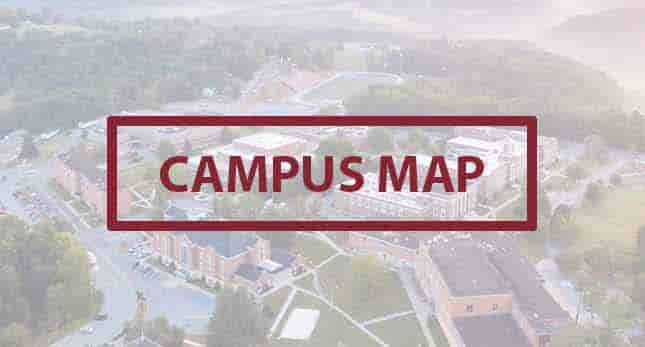Concord University’s Mission
The mission of Concord University is to improve the lives of our students and communities through innovative teaching and learning, intellectual and creative activities, and community service and civic engagement.
Concord University provides accessible, affordable, high-quality, and student-centered teaching and learning opportunities strengthened by integrated support services and co-curricular programs.
Concord’s rigorous, market-driven programming provides current professional knowledge and essential communication, numerical, and critical thinking and reasoning skills, necessary for life-long success in a dynamic and culturally diverse world.
Concord’s mission immerses people in intellectual inquiry to expand knowledge, encourages and supports creative activities and the arts, and contributes to community engagement and economic development to enhance the quality of life in the region and beyond.
Concord’s mission will achieve our vision to transform lives, enrich our communities, and prepare leaders for service regionally, nationally and internationally.
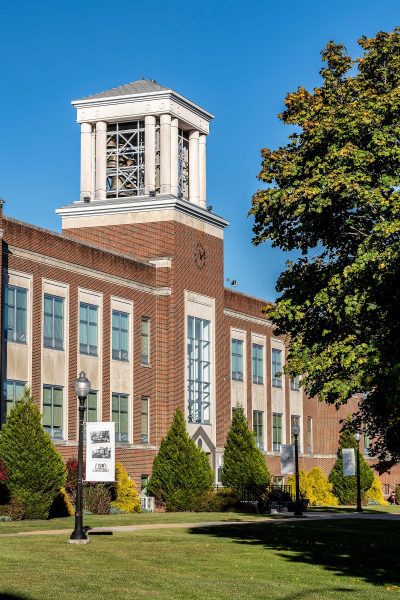
Concord University Goals Preamble
Concord University strives to ensure that students come away from their experience with knowledge and skills that will enable them to fulfill their personal and professional aspirations and awareness in respect to their chosen discipline. The learning goals and outcomes are derived from national research and best practices surrounding liberal arts education and Concord University’s mission. The goals are a shared vision of what is expected of all Concord graduates. The educational programs of Concord University are designed to foster knowledge/mastery of content, critical thinking, communication, and personal, civic, cultural, and global competence.
General education, the core of all undergraduate curricula, is an essential element in an educational process designed around student learning expectations. Continuous improvement of courses, curricula, and programs is essential for institutions to ensure the improvement and sustainability of student learning and effective instruction. Assessment of general education is not only necessary to satisfy accrediting bodies and stakeholders, but to provide evidence to answer our own question –Did students learn what we wanted them to learn? (Assessing General Education Programs, Allen, 2006)
University Goals and Learning Outcomes
- Knowledge/Mastery of Content- Students will demonstrate a depth of knowledge and apply the methods of inquiry in a discipline of their choosing, and they will demonstrate a breadth of knowledge across varied disciplines.
- Critical Thinking- Student will demonstrate the ability to access, analyze, and interpret information, respond and adapt to changing situations, make complex decisions, solve problems, and evaluate actions.
- Communication- Students will demonstrate the ability to communicate clearly and effectively.
- Personal, Civic, Cultural, and Global Competence- Students will demonstrate awareness and understanding of the skills necessary to live and work in a diverse world.
A Statement on the Philosophy of Assessment and Our University Goals
Concord’s mission is clear: to provide a quality, liberal arts education that fosters scholarship, creativity, and service. Our university goals are the principal means to assess the effectiveness of our efforts to accomplish that mission. They provide a measurable, manageable, and efficient means of assessment. They render us accountable to our students, faculty, administrators, and, as a public university, the wider community. They provide a comprehensive definition of the parameters of our mission. Finally, they are inclusive, applicable to all of Concord’s academic programs, co-curricular and other activities. (T. J. McKenna, 2018)
Founded in 1872 as a state Normal School to prepare teachers, Concord University (CU) is a public, career focused liberal arts institution located in rural southern West Virginia, one of the poorest regions of the country. Concord’s evolution in many respects mirrors the historical development of other public comprehensive regional colleges—from teachers’ institutes to normal schools, to state colleges, and eventually to universities offering master’s degrees.
“All our past acclaims our future,” wrote the English poet Algernon Charles Swinburne, who was born in 1837, the same year as Mercer County, the home of Concord University, was formed in old Virginia.
In the 1840’s, to attract settlers, Colonel Henderson French established a land company in Mercer County. The early settlers felt the need for a church, and, in 1858, Colonel French gave land for this purpose. Captain William Holroyd, a licensed Methodist preacher, helped build the church, and French asked Holroyd’s wife, Sarah, to name it. On the day of dedication, she said: “This church is where all denominations shall worship together in harmony, sweet fellowship and concord, and it shall be named ‘Concord Church.’
The settlement also was called “Concord Church.” A post office was established after the Civil War, and the University got its name when, on February 28, 1872, the West Virginia Legislature passed “an Act to locate a Branch State Normal School, in Concord Church, in the County of Mercer.”
But land and a building were needed, and no State funds were appropriated. Five families – The Fannings, Frenches, Holroyds, Martins, and Vermillions-principally were responsible for meeting the challenge and getting the school established. Classes started on May 10, 1875, with 70 students. Captain James Harvey French was the first principal, and he served until his death in 1891.
Eventually, State appropriations for a new brick building were secured; the building was completed in 1887 on the site of the present Athens Middle School, and an additional appropriation in 1895 enabled it to be considerably enlarged.
In 1896, due to confusion with another West Virginia post office in Hampshire County called “Concord,” the name of the town was changed to “Athens,” an obvious choice of the old Greek city for a community that was a center of learning. But the school kept “Concord” as its name.
A tragic fire destroyed the handsome school building in November of 1910. The campus was moved to its present site, and a new building was completed in 1912 (Old Main) that currently is known as Marsh Hall.
Although firmly established, the essential character of the institution changed little during its first half century. It was small, rural, and isolated. Much instruction was only at the secondary level, and the two-year “standard normal” diplomas exceeded baccalaureate degrees through 1936. Until 1922, the only building on the present campus was “Old Main.”
During the administration of Dr. C. C. Rossey (1918-1924), residence halls for women (the former McComas Hall) and men (Holroyd), and a gymnasium were built. Also, the academic program was upgraded considerably.
Since 1929, except for the ill-fated “merger” with Bluefield State College (1973-1976), Concord has experienced outstanding growth in enrollment, physical plant, curriculum and the quality of its faculty and staff.
The administration of Dr. J. Frank Marsh (1929-1945) brought the University full national accreditation in 1931; also the institution changed its name twice, from “Concord State Normal School” to “Concord State Teachers College” in 1931, to “Concord College” in 1943.. The “standard normal” program was abolished in 1936. Marsh also greatly expanded the physical plant: an addition to the gymnasium; a President’s House and five faculty homes; a swimming pool; additional residence halls for women (Sarvay) and men (White); a library (named for Marsh); and, a home management demonstration house.
The new President’s House (1932) was built on State property with borrowed funds; Marsh personally paid monthly rent for most of the thirteen years he and his family occupied the home until the debt was satisfied. The president’s wife, Florence, enjoyed entertaining, and hardly a week passed without a dinner, a formal reception or a small party for faculty and students, State Officials, guest lecturers and artists and friends. During the 1930’s, overnight guests included Lowell Thomas, Amelia Earhart, Will Durant, Carl Sandburg, and Metropolitan Opera stars Susanne Fisher and Muriel Dickson. During her bachelor son’s presidency (1959-1973), Mrs. Marsh once again was hostess and presided over numerous social functions in the official residence. At the end of her son’s presidency, still active at age 79, she had served for 30 years as Concord’s “first lady.”
During WWII, the University experienced campus-wide change of demographics as young men went off to war, to leave a student population composed mainly of young ladies, until 1943. That year, the University housed the U.S. Army Air Corp’s 15^th^ College Training Detachment. The program, which lasted throughout the war, brought classes of young soldiers in to train them as Army Pilots. They received both military and college credit training during their time here. The cadets, even after they left Athens, left their impression on the townspeople.
During Virgil Stewart’s administration (1945-1959), the University experienced postwar growth in enrollment and physical plant. The Science Hall was built, a small temporary music building was erected, housing units for married students were constructed, and a new athletic field was developed.
Dr. Joseph F. Marsh Jr. son of the former president, served as president from 1959 to 1973. Additions to the campus during his administration were: the College Center (Student Center); new residence halls (Wilson, Wooddell, and the Twin Towers); additional married student housing; additions to the administration building; The Alexander Fine Arts Center; Witherspoon Park (faculty housing); The Leslie R. and Ruby Webb Carter Center (health and physical education); Callaghan Stadium; and the Maintenance Building. Also, the younger Marsh continued the expansion of the curriculum, emphasized quality and recruited a cosmopolitan faculty.
In 1973, the West Virginia Board of Regents had a bill introduced in the Legislature to merge Concord and Bluefield State colleges, which caused an uproar. All constituencies of Concord opposed the proposal. Although the bill failed even to get out of committee and died, the Regents pressed the matter after the Legislature adjourned and proceeded with an “administrative” merger. Since Marsh opposed the merger, he was fired and became president of a college in Pennsylvania. Dr. Billy L. Coffindaffer was appointed president of both Concord and Bluefield State, but after only two years of turmoil the Regents concluded (as Marsh had testified before the Senate Education Committee) that the arrangement would not work, announced that a return to separate administrations would take place in 1976, and appointed Dr. James Rowley as acting president during the interim.
With the administrative merger abolished, Concord enthusiastically welcomed Dr. Meredith N. Freeman as its new president in 1976. During his nine-year tenure, most of the wounds were healed, and once again enrollment increased and new academic programs were established. The physical plant was expanded with a major addition to the J. Frank Marsh Library and the development of Anderson Field.
Dr. Jerry L. Beasley, assumed the office of President on July 1, 1985, upon the retirement of Dr. Freeman. Beasley, originally from Hinton in Summers County, is a southern West Virginian who chose to remain and work in the Mountain State. During his tenure, the University’s enrollment continued to grow, and Concord developed the largest endowment of any West Virginia public college. In the late 1980’s and early 1990’s, the Physical Plant at Concord saw several major changes. McComas Hall (Women’s residence hall), the College Theatre, and the Old Gym were torn down. However, the Administration and Science buildings enjoyed a several million-dollar renovation that modernized the buildings.
During Dr. Beasley’s administration, Concord received national notice for its progressive efforts. These included the student volunteer organization HAPIN; the Summer Academy and Teacher’s Institute, enriching learning in West Virginia secondary schools; the Concord Quest for Scholars; and the Bonner Scholars Program. Concord is the only state-assisted college chosen to participate in the entire Bonner Scholars program, which has 80 participants annually, learning what it means to lead by serving. Beasley’s administration also established a “Beckley Center” for Concord and developed a master’s program in Teacher Education. The University’s name was changed to Concord University in 2004 to reflect University’s change in classification. Additional Master’s programs have since been developed for Social Work. Teaching, and Health Sciences.
Dr. Gregory F. Aloia began his five year tenure as Concord University’s president in July 2008.
Under his guidance, Concord became a national leader in serving student veterans and was recognized as the top veteran friendly university in the United States. In 2011-12, Concord was recognized as the number one most veteran friendly campus in America. Dr. Aloia implemented international initiatives that increased the number of international students on Concord’s campus and the University’s participation in educational opportunities for faculty, and students on a global perspective.
During his time as president, Dr. Aloia and his leadership team were dedicated to increasing opportunities for professional development for the staff and faculty, increasing the number of full time faculty, supporting the expansion of graduate programs, improving the excellence of the university’s athletic teams, expanding library access and enhancing the overall experience for students at Concord. Other highlights of his administration include establishing the annual Founder’s Day Convocation celebrating the institution’s initial charter in 1872, the opening of the alumni center and interfaith chapel at University Point, renovations to the physical plant and the restoration and beautification of the campus grounds.
Mrs. Mary D. Aloia served alongside Dr. Aloia as the first lady of Concord, strongly supporting the students and was instrumental in reestablishing the university’s annual printed yearbook in 2008. Both Dr. and Mrs. Aloia began a tradition during finals week of insuring that students had 24 hour access to the library, along with nightly coffee and cookies, “midnight” breakfasts on Tuesdays, and giving Snickers candy to students each night of finals week.
The first light of Concord was a flickering candle, but the flame did not die. Today, the light burns brightly. In the future, the light of Concord University will shine more widely and strongly. (Adapted from an earlier piece by J. F. Marsh.)
Following the departure of Dr. Aloia in June 2013, Concord’s Vice President and Academic Dean, Dr. Kendra Boggess, was named the University’s new Interim President in July 2013.
Dr. Boggess understood the challenges that Concord was facing because of her experience as a long-time faculty member, Division Chair, President of the Faculty Senate, Associate Dean, and Vice President and Academic Dean. Concord faced some very difficult issues including: cuts in state appropriations that would eventually exceed 20%, declining student enrollment due to negative economic and demographic trends in southern WV, and declining financial performance reflective of the higher education situation found in other states as well.
Following her 2014 appointment as the 11th President of Concord University and first female President, Dr. Boggess, together with her leadership team, implemented systematic plans addressing political, structural, and resource issues. Dr. Boggess has provided strong leadership during recent turbulent times in higher education nationally and major disruption of higher education finances during a protracted economic downturn in southern West Virginia. Boggess led university renewal projects that have driven over $3 million of costs out of the system restoring positive changes in net position and achievement of financial stability during fiscal year ending 2018, while advancing the University’s long-standing mission.
Under her leadership, the general education program has been reformed to provide students with expanded choices among liberal arts and science courses, academic programs have been added, expanded, or refreshed, and under-utilized academic programs have been either reformed or sunset to better align scarce resources with Concord students’ key academic and operational priorities. Also, to further enhance students’ on campus experiences, Wi-Fi technology in all facilities now provides students access to 1 Gigabyte bandwidth, lighting has been upgraded to the latest LED technology in all facilities and external areas. The university recently renovated and modernized two Towers residence halls to better support its 40% on campus residential students and has decreased deferred maintenance of university facilities.
Concord continues to provide a quality, liberal-arts based education to its students, engage in scholarly and creative activities, and continue a long tradition of serving the regional community.
| Principals: | Years of Service: |
| Captain James Harvey French, LL.B. | 1875-1891 |
| John D. Sweeney, B.S., M.S. | 1891-1897 |
| Captain George Michael Ford, A.B., LL.B. | 1897-1900 |
| Elmer F. Goodwin | 1900-1901 |
| Arthur S. Thorn, A.B. | 1901-1906 |
| Frances Isabel Davenport, B.S. | 1906-1907 |
| Charles L. Bemis, B.S. | 1907-1913 |
| Lawrence Benjamin Hill, A.B., A.M., Ph.D. | 1913-1918 |
| Presidents: | Years of Service: |
| Christopher Columbus Rossey, B.Ped., Litt.B., M.A., Ed.D. | 1918-1924 |
| George West Diehl, A.B., B.D., M.A., D.D., LL.D. | 1924-1929 |
| Joseph Franklin Marsh Sr., B.Ped., A.B., A.M., Ped.D. | 1929-1945 |
| Virgil Harvey Stewart, A.B., A.M., LL.D. | 1945-1959 |
| Joseph Franklin Marsh, Jr., A.B., M.P.A., LL.D., L.H.D. | 1959-1973 |
| Billy Lee Coffindaffer, B.S., M.S., Ph.D.* | 1973-1975 |
| James Walton Rowley (Acting), A.B., M.A., Ed.D.* | 1975-1976 |
| Meredith N. Freeman, B.S., M.Ed., Ed.D. | 1976-1985 |
| Jerry L. Beasley, A.B., Ed.M., Ph.D. | 1985-2008 |
| Gregory F. Aloia, B.A., Ph.D. | 2008-2013 |
| Kendra Boggess (Interim), B.S., M.S., Ph.D. | 2013-2014 |
| Kendra Boggess, B.S., M.S., Ph.D. | 2014-Present |
Concord was granted a charter by the West Virginia Legislature on February 28, 1872.
| 1872 – 1931 | Concord State Normal School |
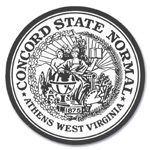 1915
|
| 1931 – 1943 | Concord State Teachers College |
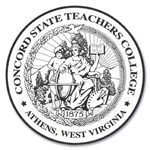 1931
|
| 1943 – 2004 | Concord College |
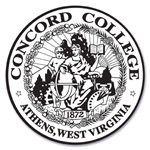 1943
|
| 2004 – Present | Concord University |
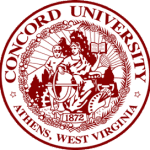 2004
|
The Official Seal of Concord University
In the spring of 1915, Concord felt the need for a seal that could be used in the school catalog and other material. Dr. Felix Yanowski a Concord chemistry professor was commissioned to design a seal for the institution. The faculty adopted it as the official seal of the institution on March 31, 1915. The only changes made since then have been to change the name to correspond with the name changes of the institution, and to use the date 1872 as the year of Concord’s charter. Concord’s Board of Governors approved the new name, “Concord University,” July 1, 2004.
Around the seal is a wreath made of pine leaves, denoting dignity, and oak leaves, denoting strength. At the top of the wreath is a dove of peace. In the center of the seal can be seen the figure of a teacher who is imparting learning to an eager student standing beside him. In the teacher’s hand is a book of literature. At his feet is a palette denoting art. The globe before him signifies science; the dividers are a symbol of mathematics. The vase and cogwheel represent artisanship and industry. In the background are oak trees, symbolic of the forest of West Virginia, and the rhododendron, the state flower. The 1927 Pine Tree yearbook described the remainder of the seal thus: “In the glow of the setting sun, forming a background for this symbolic picture, we see a scene of majesty and splendour, the beauty of those West Virginia Hills.”
The above description and early history of the seal were adapted from the unofficial history of Concord University, The Pines, and the 1927 Pine Tree.
Approximately half of Concord’s students receive Pell grants and over 40 percent are the first in their families to attend college.
The University’s primary service region includes eight counties (Fayette, Greenbrier, McDowell, Mercer, Monroe, Raleigh, Summers, and Wyoming) in southern West Virginia and two counties in Virginia (Bland and Giles). Southern West Virginia is geographically bound by mountains that often make the commute between distances longer than the actual mileage indicates. Coal mining provided the economic basis for the majority of communities and small towns in this region throughout the twentieth century. Most recently, southern West Virginia has struggled with the decline of coal, a declining state economy, and a declining school-age population. Since its inception, Concord has been proud to serve this region and provide access to quality higher education for many first-generation college students.

